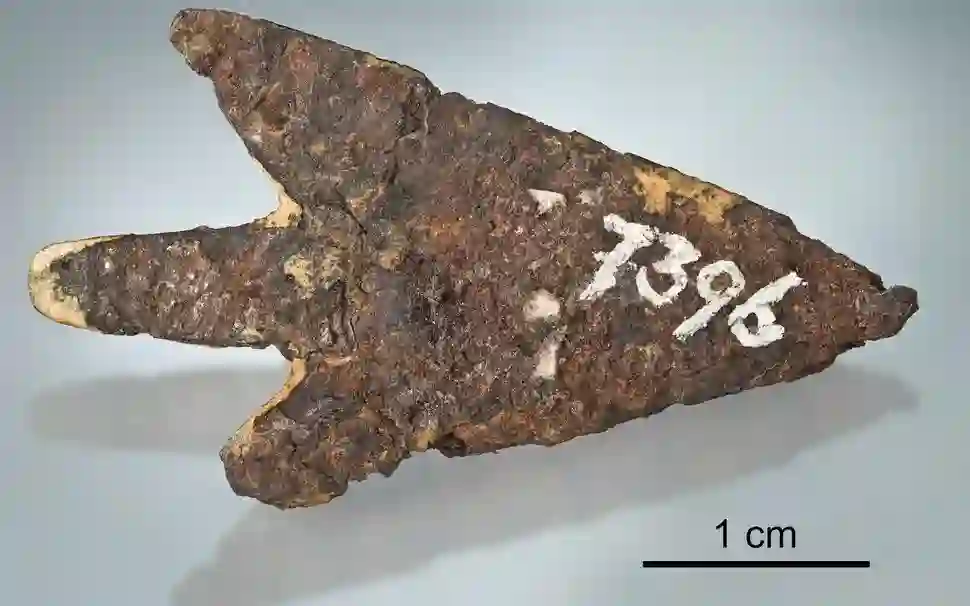Unearthed in the late 1800s at a Bronze Age dwelling in Mörigen, Switzerland, a seemingly ordinary bronze age arrowhead has now been revealed as an extraordinary artifact crafted from a meteorite that plummeted to Earth around 3,500 years ago. The fascinating findings of this research have been unveiled in a study published in the September issue of the Journal of Archaeological Science.

Multiple methods, including cutting-edge X-ray tomography and gamma spectrometry, were employed to scrutinize the bronze age arrowhead. (Photo: The Sun)
Bronze Age Arrowhead Turns Out to be Meteorite-Carved
According to Space, lead author Beda Hofmann, an expert in mineralogy and meteorites at the Natural History Museum of Bern, described the initial appearance of the bronze age arrowhead as deceivingly commonplace.
“On the outside, it looks like a typical arrowhead coated in rust,” Hofmann shared in an interview with Live Science. However, beneath its unassuming exterior, advanced analysis techniques have unveiled a treasure trove of information.
Multiple methods, including cutting-edge X-ray tomography and gamma spectrometry, were employed to scrutinize the bronze age arrowhead. These analyses not only uncovered aluminum-26 isotopes that are absent in terrestrial materials but also identified traces of iron and nickel alloy consistent with meteoritic composition. This groundbreaking revelation offers a glimpse into the ingenious adaptation of natural resources by ancient craftsmen.
Evidence of skilled craftsmanship emerged from the analysis as well. Traces of grind marks bore testimony to the meticulous shaping of the meteorite into an arrowhead. Furthermore, remnants of tar were detected, suggesting that the point was affixed to the shaft using this adhesive substance.
READ ALSO: 95-Foot Asteroid 2022 BS2 to Safely Approach Earth Today: Here’s What You Need to Know!
Studying the Bronze Age Arrowhead
Researchers initially associated the artifact with the Twannberg meteorite site, which is located a mere 5 miles away from the discovery site. However, a deeper investigation revealed that the bronze age arrowhead’s nickel and germanium concentrations did not align with those found at the meteorite site.
Consulting geological databases, the team identified a correlation between the metals present in the artifact and those from the Kaalijarv meteorite site situated in Estonia, a staggering 1,400 miles away. This revelation pointed towards the possibility that the bronze age arrowhead had been traded over vast distances during the Bronze Age.
Hofmann elaborated on this notion, emphasizing that historical evidence supports the idea of long-distance trade during the Bronze Age. “These early people likely knew that when the impact happened there in 1500 B.C., the material was precious and had value to it,” Hofmann stated.
This bronze age arrowhead, weighing a mere 2.9 grams and measuring just over 1 inch in length, shines a light on the remarkable interconnectedness of ancient civilizations.
Its journey from the depths of space to the hands of Bronze Age hunters, coupled with its eventual display at the Bern Historical Museum from February 1, 2024, to April 25, 2025, serves as a testament to the enduring fascination and innovation that has characterized humanity’s relationship with the cosmos throughout history.
In today’s world, meteoritic arrowheads remain exceptionally rare, with a mere 55 known examples discovered across 22 sites in Eurasia and Africa, as highlighted in the statement released by the research team.
READ ALSO: AI program finds ‘possibly hazardous’ 600-foot-wide asteroid, a first in astronomy




![Tyson Foods Plant [Photo: Food Manufacturing]](https://southarkansassun.com/wp-content/uploads/2023/08/iStock_1185520857__1_.5e441daa51cca-600x337.jpg)








![Silverado Senior Living Management Inc. [Photo: Los Angeles Times]](https://southarkansassun.com/wp-content/uploads/2023/10/download-6-4-600x337.jpg)

![China's Wuhan Institute of Virology [Photo: Nature]](https://southarkansassun.com/wp-content/uploads/2023/09/d41586-021-01529-3_19239608-600x337.jpg)















